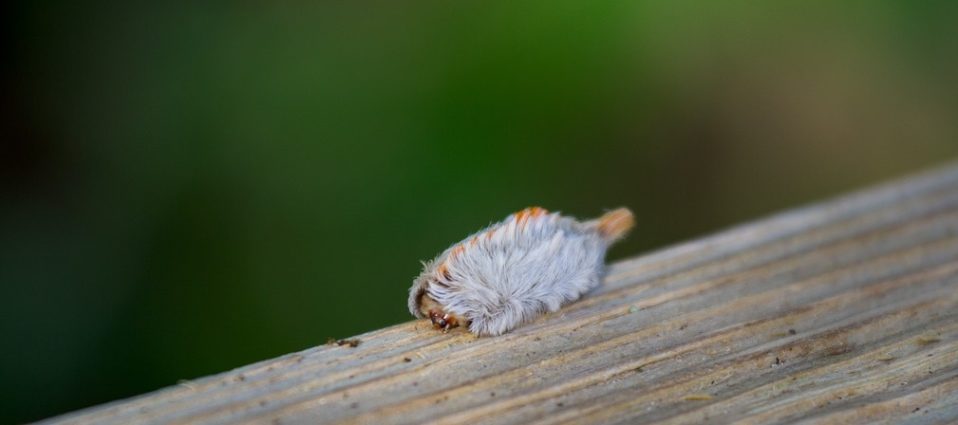Wildlife Wednesday: Stinging Caterpillars
Autumn is time for all kinds of natural phenomena in the Houston area: bird and butterfly migration, many trees and bushes bear fruit, and leaves change color. The one common fall occurrence that most people could do without, however, is the emergence of stinging moth caterpillars. The stings of these larvae can range from mild annoyance to extreme pain, with some other mild health effects.
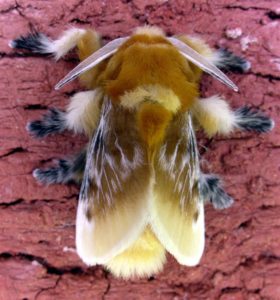
Caterpillars have a few ways to protect themselves. Swallowtail butterfly caterpillars have foul smelling horn like osmeteria which they use to dab nasty chemicals on potential predators. Some caterpillars can jump and wriggle wildly to escape predators. Some caterpillars have copious hairs and spines that are hard for predators to swallow. The caterpillars of some moths and butterflies have urticating hairs and spines (spines and hairs connected at the base to sacs of venom kept under the skin), that can deliver painful stings. We take a look at a few of these locally found stinging moth caterpillars today.
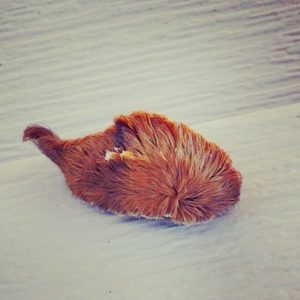 The most infamous of our stinging caterpillars is the Asp or the caterpillar of the Southern Flannel Moth (Megalopyge opercularis, pictured right). Asps usually emerge from their eggs in mid to late Autumn, and are commonly found in or near hardwood trees, shrubs, and vines. They feed on the leaves of these plants, and wander around constantly, looking for food, and eventually for decent locations to make their cocoons. They may be various shades of brown and gray, with a fur ridge down the middle of the back.
The most infamous of our stinging caterpillars is the Asp or the caterpillar of the Southern Flannel Moth (Megalopyge opercularis, pictured right). Asps usually emerge from their eggs in mid to late Autumn, and are commonly found in or near hardwood trees, shrubs, and vines. They feed on the leaves of these plants, and wander around constantly, looking for food, and eventually for decent locations to make their cocoons. They may be various shades of brown and gray, with a fur ridge down the middle of the back. 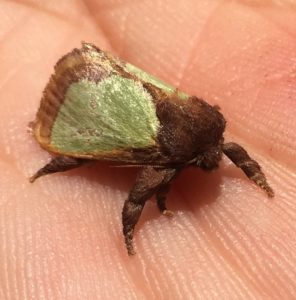
The infamy of these furry little larvae lie in their incredibly painful sting. Hidden in the fur ridge on their backs is a line of sharp little venomous spines. Stings from these spines may cause severe pain, nausea, light-headedness, swelling and redness of the sting site, burning sensation, and shortness of breath.
Of course, if you experience an extreme of any of these symptoms, or several of them for an extended period, you should see a medical professional for treatment. Home treatment includes removing the spines from the skin with scotch tape and topical treatment (with calamine lotion, baking soda, anti-histamine or pain relief lotions). Similar methods are recommended for other caterpillar stings, as well.
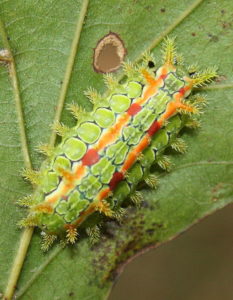 The Spiny Oak Slug (Euclea delphinii) is the caterpillar of an adorable furry little green and brown cup moth (pictured above right). While the caterpillar is really quite beautiful with its intricate designs of yellow and green or brown and orange, the pain from the stings is not at all adorable. These small spiny larvae (growing to only 2 cm long) feed on a wide variety of leaves from deciduous trees, bushes, and vines. In the South, they have 2 generations, one in the Summer, and another active in Fall.
The Spiny Oak Slug (Euclea delphinii) is the caterpillar of an adorable furry little green and brown cup moth (pictured above right). While the caterpillar is really quite beautiful with its intricate designs of yellow and green or brown and orange, the pain from the stings is not at all adorable. These small spiny larvae (growing to only 2 cm long) feed on a wide variety of leaves from deciduous trees, bushes, and vines. In the South, they have 2 generations, one in the Summer, and another active in Fall.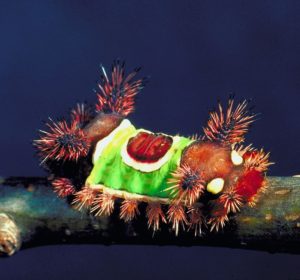
The Saddle Back Caterpillar (Acharia stimulea) is the larva of another small and furry shiny brown cup moth (down and right) with bunches of sharp rigid stinging spines, found in bunches at the front and back and along the sides of the caterpillar’s body. This is another caterpillar with an extremely painful sting, that may cause other aforementioned symptoms. As with the other two species, they feed and are found around a wide variety of deciduous hardwood tree, bushes, and vines. They may reach a length of up to 4 cm.
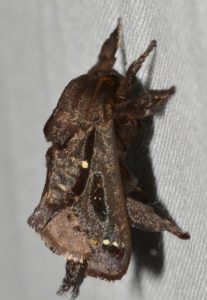 Well, we hope this little mini-guide to stinging Fall caterpillars helps you stay safe out in your yard, garden, and out in area parks in the coming weeks. Though painful at times, they are important herbivores in our native ecosystems, and they really can be quite beautiful and even endearing.
Well, we hope this little mini-guide to stinging Fall caterpillars helps you stay safe out in your yard, garden, and out in area parks in the coming weeks. Though painful at times, they are important herbivores in our native ecosystems, and they really can be quite beautiful and even endearing.
Thanks for joining us again, and see you soon!
Eric Duran
Staff Naturalist
Photographs: Top Asp – Rain0975 | Flickr; Flannel Moth – Patrick Coin | Wikimedia; Asp – Amizrachi | Wiki; Slug moth – Eric Duran; Oak Slug Caterpillar – Shaina Noggle | Wikimedia; Saddleback Caterpillar – Gerald Lenhard/LSU | Wiki; Saddle back moth – Andy Reaggo and Chrissy McClarren | Flickr


